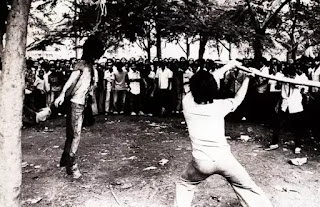Remember the Thammasat Massacre as an act of organised hate Thailand Massacre (Neil Ulevich)
Remember the Thammasat Massacre as an act of organised hate
Thailand Massacre (Neil Ulevich)
Neal Ulevich won the 1977 Pulitzer Prize for a “series of photographs of disorder and brutality in the streets of Bangkok, Thailand”
The Thammasat University Massacre took place on October 6, 1976.
It was a very violent attack on students who were demonstrating against Field Marshall Thanom Kittikachorn. Protestors and students were beaten, mutilated, shot, hung and burnt to death.
The desecration of corpses on 6 October 1976: who, how and why
It is not the number of the deceased (40)
that has made the massacre of students at Thammasat University on 6 October 1976 linger in the memories of no small number of people, so much as images showing the unthinkably savage actions committed against the victims. But we would be mistaken to think that it was only those most repulsive actions that led to the deaths of people that day.
From careful study of the available evidence, we have found only one person who lost their life due to mob vigilante violence or torture. Instead, bodies were often brutally treated after the victims had already died. Several victims lost their lives from bullets or explosions,
but their bodies continued to be assailed long after the life had left them. The images of 6 October that have circulated in the aftermath are then images of crowds egging each other on to desecrate the deceased.
That knowledge may provide us some small comfort that the victims did not have to endure such intense torture while alive, but it also raises formidable questions. Why did people feel compelled to treat the bodies of the deceased so savagely—in public before thousands of eyes,
in front of state officials and in the company of hundreds of both Thai and international journalists? How are we to understand the public desecration of corpses in Thai society?
The available evidence
People engaged in the following cruelties on the morning of 6 October:
Hanging people and taking turns to strike and kick the bodies, using knives to wound the bodies, using planks of wood and chairs to repeatedly beat the bodies, stuffing shoes into the mouths of those who were hung (we know of five people who were hung)
Pulling bodies along the ground by cloth tied around their necks, or by the legs of their trousers
Hammering wood into the chests of the deceased
Piling and setting fire to four bodies, to the point it was impossible to determine the sexes of the deceased
Urinating on unmoving bodies
Undressing the body of a deceased young woman and placing pieces of wood on top of her body in a sexually suggestive arrangement (more on this below).
We have been able to determine some details about some of the individual victims of 6 October, including names, the causes of their deaths, and the maltreatment their bodies subsequently faced.
We compiled this information from a large collection of photos and videos taken that morning, as well as medical, police and hospital autopsy reports.
1. Wichitchai Amornkul (second-year student at the Faculty of Political Science, Chulalongkorn University)
Wichitchai was 1 of 5 people lynched at Sanam Luang.
The autopsy revealed Wichitchai died from being struck with a heavy object and from being choked
Photographs that show Wichitchai’s tongue sticking out from his mouth suggest that he was likely hung before his death. In any case, several photographs and the autopsy report indicates that crowds continued to mistreat his body even after life had left it. Crowds gathered to strike and kick him, beat him with a chair, and stuff a shoe in his mouth.
His shirt was removed and sharp objects were used to slice both the front and back of his body. Wounds etched his face and all over his body. More photos are available here.





Comments
Post a Comment